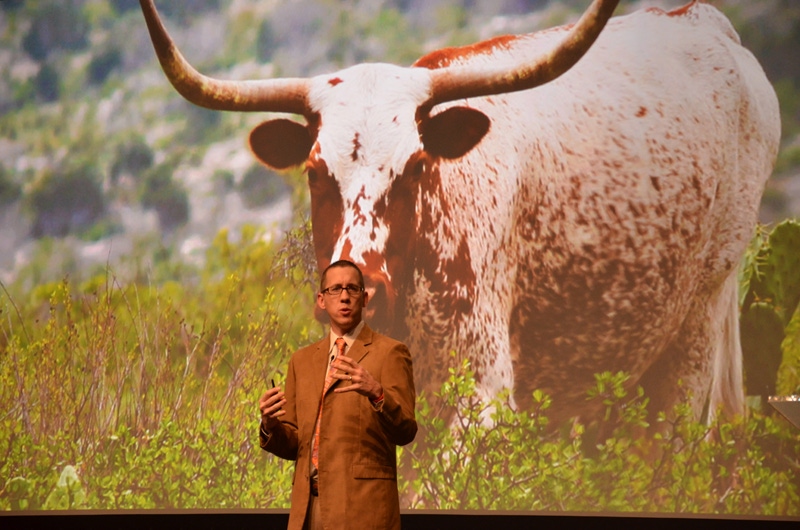CattleFax: Better weather, continued strong feeder prices on tap for 2015
Annual CattleFax outlook session predicts continued cow-calf profits.

Last year’s cattle market was indeed one to remember; in fact, it may be one that cattle producers won’t see again for a very long time, if ever. And for cow-calf producers, profitability may well be extended for the next several years as beef demand continues to outstrip supply.
For other cattle producers who are margin operators, particularly cattle feeders, the outlook is more tenuous, however. “The expectation is that 2015 prices will be higher across all major beef and cattle segments,” CattleFax predicts. “However, margin realignment is a concern—reducing stocker and cattle feeder margins and maintaining most of the historically high margins enjoyed by the cow-calf segment in 2014.”
That was the general tone of the annual CattleFax Outlook session at this week’s Cattle Industry Convention in San Antonio. “Stick to your knitting and watch your margins,” advises CattleFax CEO Randy Blach.
The CattleFax session is one of the most anticipated and well-attended features of the Cattle Industry Convention. And this year’s outlook didn’t disappoint, especially for the cow-calf producers in the audience.

Photo highlights from Cattle Industry Convention
Cattle producers from across the country are gathered in San Antonio, Texas, for the annual Convention & Trade Show. Browse photo highlights here.
According to Art Douglas, CattleFax weatherman for nearly 40 years and professor emeritus at Creighton University, this year’s weather pattern may show a reversal of past conditions. “We may have delayed planting (in the Midwest) due to cool temperatures this spring,” he told cattle producers. “Temperatures will be cooler in the Southwest with improved precipitation. For the Midwest, it will be cooler and drier.”
That means the drought is not over. “The forecast through early spring indicates that drought conditions are now likely to remain unchanged from Northern California into the Northern Plains and Upper Midwest,” he predicts.
That will be one of several factors that will affect the corn market in 2015, says Mike Murphy, CattleFax grain analyst. “U.S. corn acreage is expected to decline 1 to 2 million acres in 2015,” he predicts, but told cattle producers that yields should hit trendline expectations and be somewhere in the low 160 bushels-per-acre range. If that comes to pass, we’ll have a smaller corn crop than 2014, but still sufficient enough to keep the stocks-to-use ratio stable. That indicates corn will trade from $3.50 to $4.25 per bushel the second half of the year.
Cattle price outlook
The news was every bit as good when CattleFax rolled out its cattle price outlook for 2015. As was the case last year, cattle prices will largely be driven by continued tight supplies for the next several years, says Kevin Good, CattleFax senior analyst.
“Heifer slaughter in 2014 was the lowest it’s been in 20 years,” he told producers. “We’ll continue to keep heifers back in 2015 and 2016,” meaning heifer numbers in feedyards will continue to remain tight.
For fed cattle, Good says prices will average $157 per cwt for the year, with a range from the $140s to the $170s. “Cattle feeders are expected to bid aggressively for cattle, even as margins suffer. Expect negative feeding margins on average in the first half of 2015 and improving margins in the second half of the year.”
That aggressive attitude by cattle feeders will keep calf and feeder prices well supported. Good expects prices for 750-pound steers to average $2.20 per pound, fluctuating between $1.95 on the low end with a possible high of $2.40. Stocker and backgrounding margins will be positive but smaller than 2014, he says.
For cow-calf producers, the outlook remains positive. Good predicts 550-pound calves to average $2.60 per pound for the year, with a range from $2.35 on the low side to $2.90 on the high end. “The calf market will benefit from an improved forage situation, cheaper grain prices and record margins for cattle feeders and stocker operators last year,” he says.
That outlook indicates that bred heifers will continue to command strong prices. Historically, it takes 1.5 to 1.6, 550-pound steer calves to pay for a bred female, Blach told the audience. Given that relationship, bred heifers ranging from $2,300 to $2,600 are not out of line.
However, Blach cautions, volatility in the cattle market will continue to be a factor to keep an eye on, making risk management more critical than ever. “Access to adequate amounts of capital and credit will be a limiting factor for many producers moving forward,” he says. “Producers need to invest more time and energy in building risk management plans and programs that are in balance with their appetite for more credit.”
And cattle producers must recognize that as the industry restocks and numbers increase, prices will react. “Growing supplies over the next several years will rebalance the normal price and margin environment among industry segments. Prices will then retreat back to the lower end of the new trading range.”
However, opportunities will continue to remain for much of the beef business. “Cow-calf producers who can minimize costs and maximize production will enjoy a profitable four to five-year period,” Blach says.
You might also like:
100 biggest seedstock producers in the U.S.
6 things to consider as you clean out the vet cupboard
Prevention and treatment of cow prolapse
4 ways to raise better beef in 2015
Meet the biggest bull seller in the U.S.
9 ranch management concepts to improve your ranch
3 ways mineral supplementation is key to optimal performance in beef cattle
About the Author(s)
You May Also Like


.png?width=300&auto=webp&quality=80&disable=upscale)
